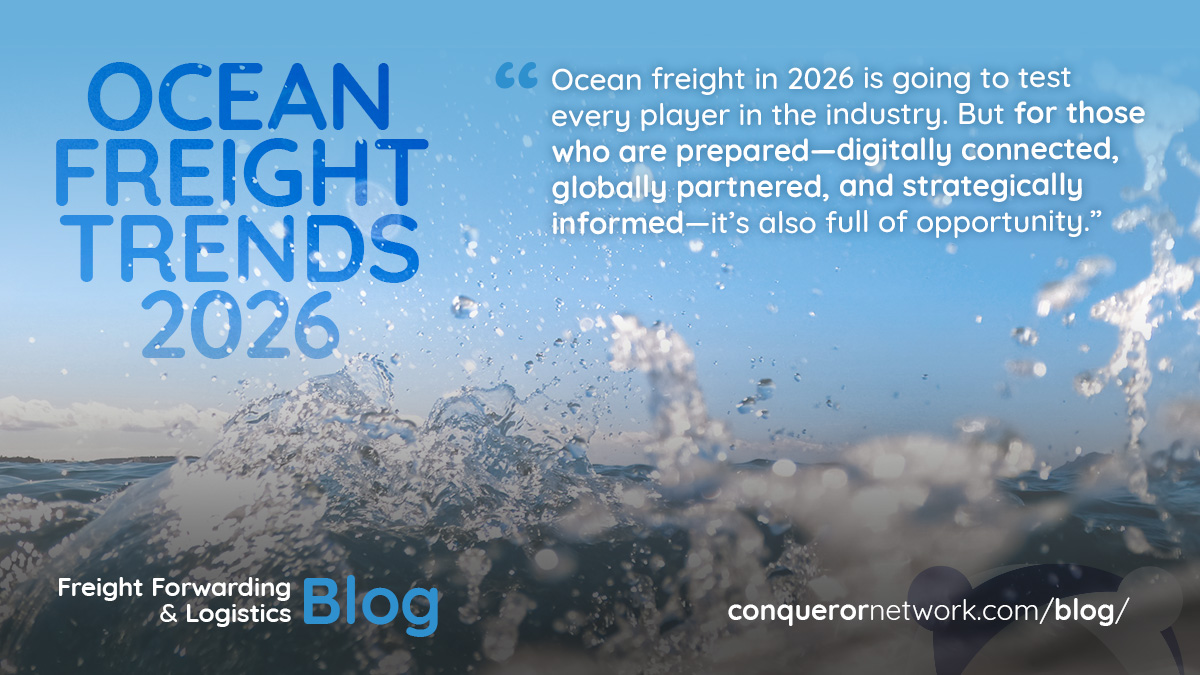2026 is going to reshape how the shipping world operates. Here’s how freight forwarders can stay ahead with real insights, real action, and real partnerships
Ocean freight is evolving fast. Sustainability is now a compliance issue. Trade lanes are shifting. Rates remain volatile. And digital transformation isn’t optional anymore. In short, if you’re a freight forwarder, the decisions you make now will define whether you grow or get left behind in 2026. This blog breaks down the key ocean freight trends 2026 will bring, and why forwarders need more than just good instincts to stay competitive. Let’s get into it.

1. Green shipping is now a cost of doing business
The IMO and EU aren’t bluffing. The carbon intensity regulations and emissions trading schemes coming into full force mean every container moved in 2026 will carry a “green cost.” Whether it’s low-sulphur fuels, methanol-powered ships, or route optimization tech, ocean carriers are passing sustainability expenses down the line.
What does this mean for you? Expect environmental fees to appear as standard. Clients will need explanations. You’ll need answers. And being able to offer greener routing options or at least clarity will become a competitive advantage.
2. Digital forwarders will win the client battle
Ocean freight trends in 2026 are all about tech-enabled service. Real-time quoting, eBLs, AI-assisted schedule planning, predictive rate tools, it’s already happening. The problem? Many traditional forwarders are still using Excel and WhatsApp to run operations.
If you want to stay relevant in 2026, you need to:
-
Automate repetitive tasks
-
Improve visibility for clients
-
Reduce delays in booking and quoting
-
Integrate with digital carriers and TMS platforms
Otherwise, digital-first competitors will win on speed, accuracy, and trust
3. Asia’s trade influence will keep shifting West
The manufacturing shift out of China continues. Vietnam, India, and Indonesia are taking on more global production, and ocean carriers are launching direct routes from these ports to Europe and the US.
Expect more frequent sailings from:
-
Hai Phong and Ho Chi Minh City
-
Chennai and Mundra
-
Jakarta and Surabaya
If your network doesn’t already have strong partners in these locations, it’s time to make moves.
4. Freight rates: Still volatile, but less of a mystery
Don’t expect smooth sailing here. Rates will keep spiking and dipping thanks to fuel prices, labor unrest, weather, and capacity swings. But you’ll also see better forecasting tools and contract options that reduce some of the chaos.
Smart forwarders will lean into:
-
Data-driven rate predictions
-
Strategic long-term contracts
-
Risk-sharing agreements with clients
You won’t control the market, but you can control your preparation.
5. Port bottlenecks and climate shocks will shape routing
More trade doesn’t mean smoother ports. In 2026, ports will still face climate-related disruptions such as heatwaves, typhoons, floods and some terminals will lag behind in automation upgrades. What’s the move? Don’t rely on one port or one plan. Build flexibility into your routing. Use your global contacts. And work with partners who can shift cargo quickly when things go sideways.
7. Ocean freight trends 2026: A quick action plan
Let’s recap. Here’s what freight forwarders should start doing now to ride the wave in 2026:
-
Digitize fast or risk falling behind.
-
Track carbon and regulatory changes and educate clients.
-
Expand your global reach, especially in emerging Asian markets.
-
Plan for port disruptions and keep alternate routings ready.
-
Join a reliable freight network like Conqueror for real support and collaboration.
The role of strong freight networks in 2026
One trend that often flies under the radar but has a huge impact is the quiet shift toward stronger freight forwarding alliances. In a landscape shaped by disruptions and tighter margins, independent forwarders are leaning more heavily on networks that provide access to trusted agents, financial safeguards, and consistent business flows.
Being part of a well-structured logistics network helps level the playing field. It enables smaller players to handle global shipments with the same confidence and efficiency as larger multinationals. Networks like Conqueror Freight Network, which offer vetted partnerships, financial protection, territorial exclusivity, and collaborative tools, are becoming increasingly essential not just for growth, but for survival.
Final word
Ocean freight in 2026 is going to test every player in the industry. But for those who are prepared—digitally connected, globally partnered, and strategically informed—it’s also full of opportunity. Don’t just react to the trends. Get ahead of them. And let Conqueror Freight Network help you get there.


